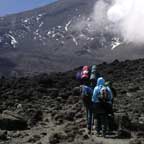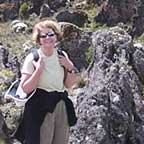
Vacations: a time for relaxing on a beach or perhaps booking some time in a posh spa, right? Would you consider climbing a mountain or sleeping in a tent in the Gobi Desert a vacation? More women are using their time off to go on adventure travel, stretching themselves to complete—or at least attempt—something out of their comfort zone.
Vicky Stewart, Dean of Planning, Research and Economic Development at Illinois Central College, is one such woman. As Stewart says, she’ll follow her daughter anywhere on this earth: Thailand, Morocco, to the top of Mt. Kilimanjaro, and on a safari in Kenya. Below are excerpts from her recent adventure as she and her daughter, joined by a group of friends, scaled one of Africa’s tallest mountains. Giving some perspective on the adventure travel trend in general is Mary Seaton, vice president and general sales manager of the Peoria, Morton, and Pekin office locations of Suzi Davis Travel.
Adventure travel has increased in popularity in the past few years, Seaton said, and one-half of all American adults—approximately 98 million people—participate in either hard or soft adventure travel.
Day 2—June 12—Travel from Nairobi to Moshi, Tanzania & Mt. Kilimanjaro
One hour into the trip, Sarah drew my attention to the snow-capped mountain of Kilimanjaro in the distance. Though far off in the distance, the mountain loomed ever larger in my mind. I wondered if I would ever see the top of the mountain.
Along the way, we briefly stopped at a rest area complete with toilet, café, and gift shop. I was amazed at the cleanliness. Remembering other adventures, I realized these Kenyans knew how to cater to tourists.
Shortly after our stop, we arrived at the border and had to vacate the bus to fill out the paperwork to enter Tanzania…By the middle of the afternoon, we arrived at the Hiker’s Lodge in Moshi. We registered at the desk and had to provide passport information as well as our tribal name. I put down “Chicago” as the tribe for Sarah and me, while Doug put down “Krispy Kreme.” Sarah and I shared a rather spartan room, but it was complete with a shower and toilet (the last that I would see for a while).
According to Seaton, the three most popular outdoor vacation activities are camping and hiking, followed by biking. “Of the hard adventure sports, several of the most popular are whitewater rafting, scuba, and mountain biking; of the soft adventures, canoeing and sailing are two of the favorites,” she said.
Day 3—(Day 1 of the Trek) The Climb Begins—1,900 meters at Machame Gate to Machame Camp at 3,000 meters
As we approached the Machame Gate, it opened and then closed behind us. The gate kept out the many entrepreneurs trying to hawk their Mt. Kilimanjaro merchandise. The first hours of the hike were filled with picture taking, stopping to greet children working along the path, and enjoying the flora (such as the Kilimanjaro Impatiens, only grown on this mountain). The porters sped by us balancing their load on their heads. Doug chose to carry his backpack the entire trip (that West Point training came in handy). Thor also carried a heavy load on his back. I wouldn’t have made it two feet with mine. Despite their loads, they often made the journey in half the time that it took us.
I didn’t sleep well the first night, worried about what was ahead. The lack of sleep made day number 2 of the climb really rough, and I quickly learned that you take advantage of opportunities to sleep.
Seaton said adventure is practically built in for cruise vacationers. “The options are endless: scuba, hiking, whitewater rafting, rock climbing, and the newest excursion, the canopy adventure. This is an extreme experience, flying through the trees on the zip-lines, 60 feet above the canopy in the tropical forests.”
Day 4—(Day 2 of the Trek) 3,100 meters to 3,982 meters and down to 3,820 meters to sleep; Machame Camp to Shira Camp
Due to our inexperience, it took us a while to ready ourselves; we were off on our five-hour trek by 9:20 a.m. Today’s hike was very vertical, and we didn’t reach camp until 3 p.m. Climbing over rocks was exhausting, and I learned to slow my pace. When I could achieve a trance-like state and focus on the feet just in front of me, I could last longer without having to stop and recuperate and catch my breath. Surprisingly, a slow pace could get you there.
When we got to camp, it was extremely windy. The wind literally howled. Sarah and I thought the tent would collapse around us.
If adventure travel doesn’t sound like the way you want to spend your vacation, consider the beach, Seaton said. “Beaches are the most popular destination, according to recent travel industry reports. One in 10 U.S. travelers goes to the beach, whether it’s for a long weekend or for an entire week. Baby Boomers generate the highest travel volume and are most likely to stay in a hotel, motel, or bed and breakfast.”  Day 5 of the Trip (Day 3 of the Trek)—3,820 meters to 4,600 meters and down to 3,900 meters to sleep; Shira Plateau and the Hike from Shira Camp to Barranco Camp.
Day 5 of the Trip (Day 3 of the Trek)—3,820 meters to 4,600 meters and down to 3,900 meters to sleep; Shira Plateau and the Hike from Shira Camp to Barranco Camp.
Each day we must reach a higher altitude for lunch and then descend back down to sleep so that our bodies can acclimatize. As we decided on Day 2 of our trip to combine a couple of days and complete the entire hike in six days instead of seven, this day was a long one.
After lunch it was mostly downhill through boulders, crushed gravel, and rocks. We had to watch that we didn’t slip. As Peter’s hiking boots had fallen apart, we offered him glue used to repair mattresses and duct tape. Peter and Doug indicated that their sleeping bags weren’t keeping them warm at night, so they headed to their tents to figure something out. It wasn’t long before we all were in bed—perhaps by 7 or 8 p.m. It gets dark early, and it was really too cold to sit out and visit.
One-fourth of all U.S. travelers go solo when vacationing, according to the Travel Industry Association. “These travelers average 42 years of age, with average income of $54,000,” Seaton said. “They’re professional or managerial and are well educated; many are young and single. TV has greatly influenced the younger generation, and reality series The Amazing Race has generated new interest in unusual travel destinations.”
Day 7—(Day 5 of the Trek)—The Summit
It was the day of the summit, and I had no energy—not one more ounce of strength. How was I going to make it to the top? I was severely dehydrated. Several hours into the hike, I started asking Sarah if it was realistic for me to keep on hiking. Paul put my arm around his neck and summoned Hesron, the assistant guide, to take my other arm. Sarah even pushed from behind. We took seven or eight more steps. Then we did it again. Then Sarah said, “Mother, you have four or five steps to go. Do these on your own.” She insisted Paul and Hesron move away from me, and I took the final four steps to the top of Stella Point. Everyone cheered and rallied to meet me. Two hours later, I reached Barafu Camp, unzipped my tent, and fell into the tent.
Seaton said adventure travel isn’t for everyone. “You must have the physical abilities to participate in many of the adventure sports. Couch potatoes are better suited to sitting on the beach; strenuous sports usually require disclaimer forms.”
Day 8 (Day 6 of the Trek)—the Final Descent to the Park Gate
The next morning, Sarah and I were still in bed when Florence and Peter arrived at camp. Too tired to get up, one of the porters had served us porridge, toast, and tea in our tent.
We had a four- to four-and-a-half-hour trek to the Park Gate. It took a total of six-and-a-half hours to trek down a mountain that took us five-and-a-half days to climb. We stopped to buy t-shirts at a little hut along the way and walked arm in arm as we passed through the gate of the park. We picked up our hand-printed certificates certifying that we made it to the top.
I was relieved to have made it to the summit and even happier that I was down off the mountain!
Seaton said many agents live travel adventures through their clients. “There’s nothing better than having a client return back to the office with stories about their trip, accompanied by pictures and videos. The only disadvantage to being a travel agent is not being able to escort each client on her planned adventure.”
As for Stewart and her party, the next legs of their east African adventure took then to Maasai Mara National Reserve for a safari and then on to a 30-hour trek back home.
Day 12
All too soon we were on the way to the airport. It’s an incredible world that we live in—so many different people, so many different cultures. There are many wonderful people doing the best with what they have. They not only survive with very little, but they enjoy life.
This entire trip was an amazing experience for me. It was a privilege to get to know some of the people of Tanzania and Kenya. The people we met were so positive. There was never a problem that couldn’t be solved, and people who had far less than we have were always willing to lend us a hand. East Africa is an incredible land, and I was fortunate to have a daughter who wanted me to explore it with her. TPW
